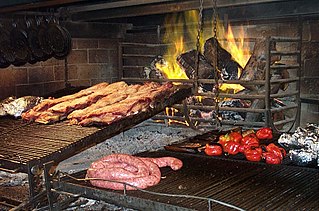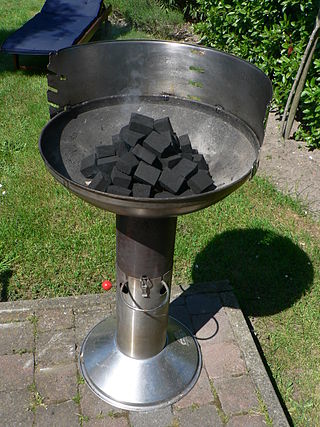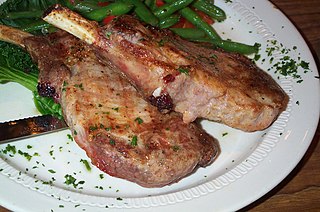
A beefsteak, often called just steak, is a flat cut of beef with parallel faces, usually cut perpendicular to the muscle fibers. In common restaurant service a single serving has a raw mass ranging from 120 to 600 grams. Beef steaks are usually grilled, pan-fried, or broiled. The more tender cuts from the loin and rib are cooked quickly, using dry heat, and served whole. Less tender cuts from the chuck or round are cooked with moist heat or are mechanically tenderized.

Louisiana Creole cuisine is a style of cooking originating in Louisiana, United States, which blends West African, French, Spanish, and Native American influences, as well as influences from the general cuisine of the Southern United States.

Brisket is a cut of meat from the breast or lower chest of beef or veal. The beef brisket is one of the nine beef primal cuts, though the definition of the cut differs internationally. The brisket muscles include the superficial and deep pectorals. As cattle do not have collar bones, these muscles support about 60% of the body weight of standing or moving cattle. This requires a significant amount of connective tissue, so the resulting meat must be cooked correctly to tenderise it. According to the Random House Dictionary of the English Language, Second Edition, the term derives from the Middle English brusket which comes from the earlier Old Norse brjósk, meaning cartilage. The cut overlies the sternum, ribs, and connecting costal cartilages.

Asado is the technique and the social event of having or attending a barbecue in various South American countries: especially Argentina, Brazil, Chile, Paraguay, Peru, and Uruguay where it is also a traditional event. An asado usually consists of beef, pork, chicken, chorizo, and morcilla; all of which are cooked using an open fire or a grill, called a parrilla. Usually, red wine and side dishes such as salads accompany the main meats, which are prepared by a designated cook called the asador or parrillero.

Schnitzel is a thin slice of meat. The meat is usually thinned by pounding with a meat tenderizer. Most commonly, the meat is breaded before frying. Breaded schnitzel is popular in many countries and is made using veal, pork, chicken, mutton, beef, or turkey. Schnitzel originated as wiener schnitzel and is very similar to other breaded meat dishes.

London broil is a beef dish made by grilling marinated beef, then cutting it across the grain into thin strips. While the inclusion of "London" in the name may suggest British origins, "broil" is not a common term in UK English, and indeed the dish is American, not British.

Cypriot cuisine is the cuisine of the island of Cyprus.

The tri-tip is a triangular cut of beef from the bottom sirloin subprimal cut, consisting of the tensor fasciae latae muscle. Untrimmed, the tri-tip weighs around 5 pounds. In the US, the tri-tip is taken from NAMP cut 185C.

Barbecue varies by the type of meat, sauce, rub, or other flavorings used, the point in barbecuing at which they are added, the role smoke plays, the equipment and fuel used, cooking temperature, and cooking time.

A meat chop is a cut of meat cut perpendicular to the spine, and usually containing a rib or riblet part of a vertebra and served as an individual portion. The most common kinds of meat chops are pork and lamb. A thin boneless chop, or one with only the rib bone, may be called a cutlet, though the difference is not always clear. The term "chop" is not usually used for beef, but a T-bone steak is essentially a loin chop, a rib steak and a rib cutlet.

Popeseye steak is thinly sliced rump steak, originating in Scotland.

A steak is a thick cut of meat sliced across the muscle fibers, sometimes including a bone. It is normally grilled or fried. Steak can be diced, or cooked in sauce, as in steak and kidney pie.

Breaded cutlet or braised cutlet is a dish made from coating a cutlet of meat with breading or batter and either frying or baking it.
Tenderness is a quality of meat gauging how easily it is chewed or cut. Tenderness is a desirable quality, as tender meat is softer, easier to chew, and generally more palatable than harder meat. Consequently, tender cuts of meat typically command higher prices. The tenderness depends on a number of factors including the meat grain, the amount of connective tissue, and the amount of fat. Tenderness can be increased by a number of processing techniques, generally referred to as tenderizing or tenderization.

Indo cuisine is a fusion cooking and cuisine tradition, mainly existing in Indonesia and the Netherlands, as well as Belgium, South Africa and Suriname. This cuisine characterized of fusion cuisine that consists of original Indonesian cuisine with Eurasian-influences—mainly Dutch, also Portuguese, Spanish, French and British—and vice versa. Nowaday, not only Indo people consume Indo cuisine, but also Indonesians and Dutch people.

















